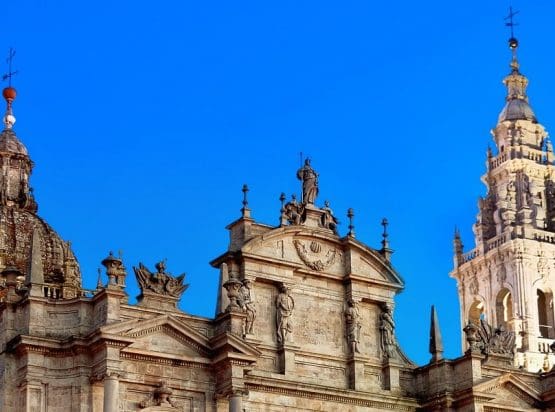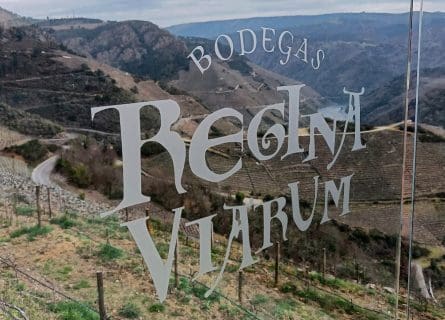Immerse yourself in Santiago de Compostela's vibrant flavors and uncover hidden culinary gems with our expert insider guides. Plan an unforgettable trip today!
Read more
EXPLORE ALL OUR GALICIA WINE REGIONS GUIDE
Last updated: August 19, 2024
Galicia is a white wine powerhouse, exporting Spain’s most fashionable white variety: Albariño. Yet this exquisite drop is far from being the only local specialty in northwestern Spain. In the impossibly steep slate terraces of Ribeira Sacra, growers produce an ever-growing volume of Mencia. Heard of it? If not, we implore you to give Mencia a try: Galicia’s star red grape yields a style of wine that is most definitely in vogue – all sappy fruit this and low alcohol that. Supple in tannin and powerful in flavor, Mencia deserves to be Galicia’s next big thing. Sommeliers, buyers, and critics are busy making it happen.
Discover more about Spanish Wine

No one knows precisely when winegrowing began in Galicia, although viticulturists are fairly sure that it predates the Romans; the Greeks, Phoenicians, and Carthaginians all imported vines to the Iberian Peninsula. Yet the unique Celtic traditions of northwestern Spain (the local dialect Gallego is one of Europe’s oldest languages) have survived until the present day, despite the Romans’ conquest in the 1st century BC.
Emperor Octavian is most directly responsible for this dramatic political shift, successfully defeating the incumbent Celtic tribes during the Cantabrian Wars. However, the peace lasted until the 5th century—the Western Roman Empire collapsed under the weight of its own hubris in 476 AD. The stability offered by the Roman administration was over.
Of course, rival civilizations have long staked a claim on the vast mineral wealth of Hispania – 476 represented a golden opportunity for several barbarian tribes in northern Europe. A Germanic race called the Suebi established the Kingdom of Galicia shortly after the disintegration of the Western Empire, although the Visigoths subsequently usurped them. Consolidating their fragile power base in Toledo, the highly Romanized Visigoths never actually numbered more than a few thousand nobles.
Thus, the stage was set for an uprising, although the foreign armies of the Moorish general Tariq swept the Visigothic aristocracy from power in 711. These Arab and Berber interlopers created one of Europe’s most advanced civilizations: Al Andlaus.
Emergence of Ribeira Sacra Winemaking
However, the Moorish armies never really attempted to subjugate Galicia, and the province was absorbed into the kingdom of Castilla y Leon. By the Middle Ages, the Christian Reconquista had pushed the Moors out of northern and central Spain, although Andalucia remained under their control until 1492.
A new winegrowing culture began to emerge in Ribeira Sacra during this period, as Benedictine and Cistercian monks relocated to the region after discovering the tomb of Santiago de Compostela. These religious orders created the first terraced vineyards (‘socalcos’ in Spanish) that now define the landscape of this spectacular region. The area’s wine industry thrived for centuries until phylloxera wiped out most vineyards, causing many impoverished farmers to emigrate to the US in the early 1900s.
Yet after Spain threw off the shackles of dictatorship in the 1970s, Galicia began to recover. Private investment has flowed into these once-neglected vineyards, transforming northwestern Spain into a wealthy and prosperous region, with exports continuing to rise. Awarded DO (appellation) status in 1996, Ribeira Sacra has gone from strength to strength.

Welcome to the ‘Sacred Shore’ of Galicia – a reference to the region’s longstanding association with Christianity and the Santiago de Compostela pilgrimage route. Situated northeast of Ourense, Ribeira Sacra’s vineyards flank both the Sil and Minho Rivers, planted on vertiginous terraced vineyards that invoke the awesome beauty of the Douro – home of Port. Indeed, with gradients rising to over 80 percent, it is little wonder that only the most dedicated farmers remain committed to growing grapes in the zone. Machine harvesting, the most cost-saving of mechanical inputs, is simply not feasible in much of the land.
Yet the terroir is undeniably first-rate. The local macroclimate is less influenced by the Atlantic than Rias Baixas, with consequently less rainfall in the summer and fall. Moreover, there is less humidity in Ribeira Sacra; fungal diseases can plague the coastal regions of Galicia, a problem that decreases as you move into the interior.
Metamorphic slate and granite soils provide warmth during the spring and offer excellent drainage during the rainy winter. The best climats (vineyard sites) enjoy a south-facing aspect and an elevated position over the river, with diurnal temperature variation responsible for the crunchy fruit and vibrant acidity that defines Galician red and white wines.
Subzones of Ribeira Sacra
The appellation is divided into five subzones:
Many growers consider the vineyards of Amandi to be Ribeira Sacra’s finest, cultivated on the north bank of the River Sil. Everything is perfect here: drainage, slope, aspect, and elevation. The vineyards of Chantada on the western shore are no less privileged in terms of aspect, although the closer proximity to the Atlantic can be a challenge in wetter years. In contrast, the mesoclimate of Quiroga-Bibei is decidedly warm due to the distance from the ocean.
However, Ribeira do Sil on the southern shore of its namesake river was once considered too cool to successfully ripen Mencia. However, climate change has reevaluated the zone’s potential. Ribeiras do Miño on the eastern slope of the river produces some of Ribeira Sacra’s best white wines: perfumed and fresh. Yet the Reds are no less impressive.

In 2018, Ribeira Sacra’s Consejo Regulador introduced some significant changes to its convoluted labeling requirements. In particular, the rules that govern the production of Tinto Ribeira Sacra Summum wines were liberalized to allow winemakers to incorporate varieties other than Mencia in the blend; regulations used to require at least 60% of the appellation’s signature red variety to qualify for DO status.
But the authorities are keen to spotlight Ribeira’s other promising grapes, not least Caino Tinto, Sousao, and even Tempranillo. Nevertheless, the Tinto Ribeira Sacra category still demands at least 70 percent Mencia in the bottle, often supported by a dash of Caino Tinto and perhaps Alicante Bouschet.
Emphasis on Mono-Varietal Wines
In addition, mono-varietal wines can be made from Albariño, Mencia, and Godello, respectively. Opinions vary wildly regarding whether a Burgundian or Bordeaux philosophy should reign supreme in northwestern Spain. We find that Mencia and Godello rarely need other grape varieties in the blend. Pure Mencia delights with its beautiful sappy fruit and expressive bouquet; it does not need embellishments.
That said, some level of maturation in wood can bring welcome structure and complexity to both Mencia and Godello wines – Albariño is easily overwhelmed by new barrique. An official DO-sanctioned designation, creatively entitled ‘Barrica,’ covers the production of oak-aged wines in Ribeira Sacra. But the requirements are hardly stringent: three months in oak for the whites and six months for local reds.
Future Prospects
Of course, leading bodegas do not have to comply with the bare minimum regulations – this becomes glaringly obvious during any tasting of the region’s top labels. Ribeira Sacra is the flavor of the month at the moment, producing an astonishing volume of high-quality wines that, for the most part, are very affordable. Expect more labels at your nearest restaurant and wine store in the future.

In the 20th century, the garagiste wineries and micro-production cuvées concept was an anathema to the Spanish wine establishment. The nation’s industry was based on volume and a generally low average price, one or two exceptions aside. Indeed, Rioja’s Consejo Regulador imposed strict rules that limited the ability of smaller estates to send their wines abroad, ensuring that the big brands dominated foreign markets. This only changed in the early 2000s, after the emerging Spanish fine wine sector introduced consumers to flavors beyond Sherry, Cava, and Rioja.
The Rise of Artisan Labels
However, artisan labels are now all the rage in Spain; about 20 percent of Ribeira Sacra’s growers market less than 5,000 bottles of wine. The rise of single-vineyard expression, meanwhile, continues to excite the critics and lure in buyers; Guímaro Finca Pombeiras is a beguiling mix of Caíño Tinto, Garnacha Tinta, Mencía, and Souson. These wines represent the future of Spanish fine wine, bringing younger drinkers into the category; older connoisseurs are likely to gravitate towards Rioja and iconic names like Vega Sicilia.
Some of the best labels, such as Dominio do Bibei’s Lapena and Rosende, are produced in tiny volumes, often less than five barrels of wine. This would have been simply unthinkable in the 1900s.
Of course, marketing scarcity from a relatively new face in fine wine can be challenging. Often sold via tight distribution channels to a very niche audience, Ribeira Sacra’s growing club of small-production labels need every advantage they can muster. Fortunately, the rise of social media marketing has made it easier to reach consumers directly, while hipster sommeliers are very much on board with the DO’s fresh and fragrant style. Today no self-respecting New York restaurant wine list can omit Ribeira Sacra. It’s just too damn cool.
Savor the Essence of Albariño: Northwest Spain's Delightful White Grape for Seafood Pairings. Explore the Lightness and High Acidity of this Galician Gem.
Find out moreDiscover Godello: Galicia's Exquisite White Wine Grape from Valdeorras. Unveiling the Delights of this Northwestern Spanish Varietal.
Find out moreUnlock the secrets of Caíño Blanco grape, an intriguing Spanish variety. Delve into its characteristics and origins, and explore the wines it produces.
Find out moreExplore the captivating world of the Loureiro grape. Discover its aromatic charm, origins, and the remarkable wines it produces.
Find out moreDiscover Treixadura grape: Origins, Flavor Profile, and Exceptional Wines—a must-read for wine enthusiasts seeking new taste sensations.
Find out moreAlicant Bouschet is a red wine grape popular in the Alentejo located in Southern Portugal. It's a cross of Petite Bouschet and Grenache grapes.
Find out moreBrancellao is an aromatic red grape variety found in Galicia, Spain, particularly in the Ribeira Sacra region. It produces wines with an elegant and refined character, showcasing vibrant acidity, fruity flavors, and a smooth texture. Brancellao is often blended with other local grapes but can also be enjoyed as a standalone varietal.
Caino Tinto is a red grape variety that is primarily grown in the Galicia region of northwest Spain. It is known for its high acidity and bright fruit flavors, which make it a popular choice for producing young, vibrant red wines.
Unearth Mencía: Spain's captivating red gem. Original and alluring, it emerges from the shadows, captivating wine enthusiasts worldwide.
Find out moreMerenzao is a red grape variety found in Galicia, Spain, known for producing wines with vibrant flavors, moderate tannins, and a distinctive character that reflects the region's unique terroir.
Discover Sezão, the dark-skinned Portuguese grape used in port and table wines, boasting rich flavors and a captivating history. 🍇🍷
Find out moreDiscover Tempranillo: Spain's iconic red grape. From Ribera del Duero to Toro, it yields concentrated wines. Explore its synonyms and unleash its prowess.
Find out moreWhen you visit Galicia, you must try the famous Tarta de Santiago, a moreish almond cake that even sugar-phobics find irresistible! Yet much of the local cuisine is a guilt-free experience, based on fresh ingredients and diet-conscious choices like Atlantic seafood, shellfish, seasonal produce, and fruit grown in market gardens. Of course, there is plenty of opportunity for gastronomes to indulge in the numerous tapas bars of Galicia, where bite-sized morsels must be enjoyed with a glass of Ribeira Sacra Godello or Mencia.
Guide to Galician Gastronomy: Read more

Immerse yourself in Santiago de Compostela's vibrant flavors and uncover hidden culinary gems with our expert insider guides. Plan an unforgettable trip today!
Read moreIf you would like us to customize an exclusive luxury tour, contact us and let us know your travel plans. We offer luxury food and wine tours for private groups of a minimum two guests. In addition, all of our private, chauffeured tours are available year-round upon request.

